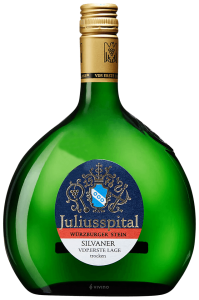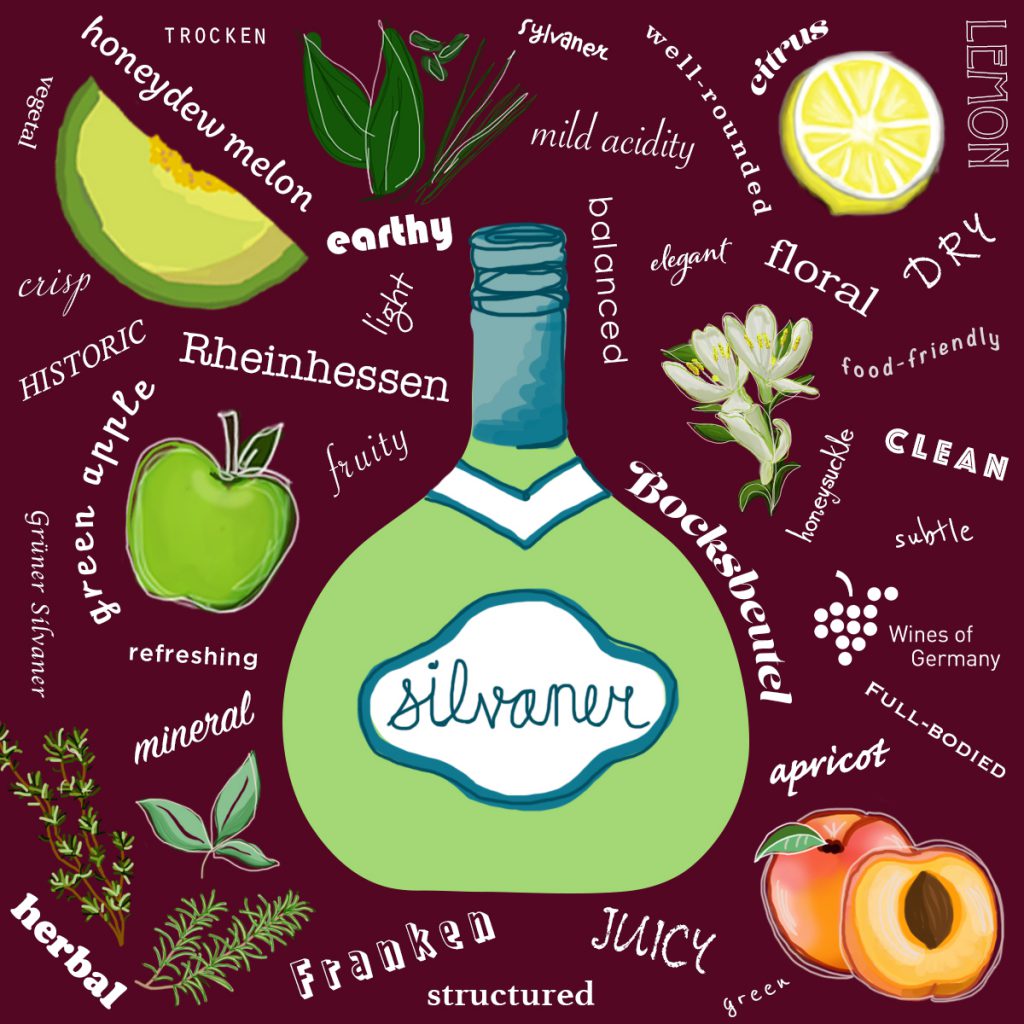Silvaner may be relatively unknown in the U.S., but few grapes can match its historical significance in Germany. Like Riesling, the country’s hallmark variety, Silvaner is terroir-expressive and incredibly diverse. Some are made to be subtle and fairly neutral, while others are powerful and mouth-filling.
While Germany is the world’s largest producer of Silvaner, the variety first appeared in nearby Austria and was brought to Germany shortly thereafter in the mid-17th century. Silvaner became so popular among German winemakers that it became the most widely planted grape variety in Germany and remained so for almost 300 years. Today, it ranks 7th among most widely planted German grape varieties.
Subtle, Stylish Silvaner
Silvaner is typically medium-bodied and has mild acidity, with earthy and mineral tones that underscore fruity notes of honeydew melon and orchard fruit and herbal or vegetal notes reminiscent of celery or fresh-cut grass.
The fresh and subtle characters are the secret to its versatility, allowing the wines to reflect the terroir in which it’s grown. Today, Silvaner is mostly vinified dry, but it can also create wonderful off-dry wines and lusciously sweet dessert wines. Further, you can find light and easy-drinking or full and complex Silvaners.
The Silvaner Story: Origin & History
The history of Silvaner is just as fascinating as its traditional odd-shaped bottle (keep reading to learn about the bocksbeutel!).
Let’s first set the stage for Silvaner’s arrival — From the mid-16th to mid-19th centuries, Germany experienced a phenomenon known as the “Little Ice Age,” with declining temperatures and shorter growing seasons. At the same time, the demand for local wines decreased when other beverages like coffee and tea became more accessible, and beer and inexpensive imported wines gained in popularity. At the start of the Thirty Years’ War in 1618, Germany’s vineyard area had reached the height of its expansion, before many vineyards were destroyed and viticulture reduced as a result of the war. Afterwards, winegrowers were forced to assess their choice of vineyard sites and grape varieties. It was during this time that Silvaner showed up!
A spontaneous crossing of Traminer and Oesterreichisch Weiss (literally, “Austrian white”), the grape came to Germany’s Franken region from Austria in the mid-17th century and quickly spread through the country, becoming the most widely-planted grape over the course of the next three centuries, until the mid-1960s.
The oldest documentation of Silvaner in Germany details the purchase of 25 Silvaner vines on April 5, 1659 by an administrator of the Castell estate in Franken, one of the oldest German wineries. They were planted at the foot of Castell’s Schossberg hill in the Reitsteig vineyard the following day.
Documents from the Ebrach Monastery dated 1665 also mention the grape. The Cistercian monks of Ebrach are credited with having imported Silvaner vines from their affiliated cloisters in Austria, and the Monastery’s abbot from 1658 to 1686, Alberich Degen, was an early propagator of the “grape from Austria.” A stone plaque commemorating Degen’s efforts to help restore viticulture in Franken was discovered in the Würzburger Stein site during vineyard consolidation in the 1960s and is on display to this day in the cellars of the historic Bürgerspital estate.
 The grape has come to be associated closely with the Franken region in particular and with the unique shape of traditional Bocksbeutel bottles of Franken – a squat green or brown flagon with a round body and short neck.
The grape has come to be associated closely with the Franken region in particular and with the unique shape of traditional Bocksbeutel bottles of Franken – a squat green or brown flagon with a round body and short neck.
Franken today has the highest percentage of Silvaner plantings (24.5%), but the largest land area devoted to Silvaner in the world is actually located in nearby Rheinhessen. Germany overall boasts around 5,000 hectares of Silvaner vines — 4.6% of the country’s total vineyard area (and over 70% of the world’s Silvaner vineyard area).
Small quantities are also cultivated in northern Italy and Switzerland, as well as in Austria and Alsace, where it’s called Sylvaner or Grüner Silvaner, with minimal quantities in a few other countries.
Growing Strong: Cultivating Silvaner
Silvaner often ripens about two weeks earlier than Riesling, likes average exposure to sunshine, and flourishes in moist soils. Leading producers plant Silvaner in top sites that are protected from wind and cold, yet have good air circulation and sufficient moisture.
The terroirs that bring forth the best of Silvaner are almost always associated with Franken’s “great Triassic trio” — colored sandstone, shell-limestone, and colored marl/keuper. The colored marl/keuper in Franken is heavy and yields very powerful, earthy wines, while the chalky marl soils in Rheinhessen yield wines that are a bit more vegetal in character. Silvaner is also a traditional variety in the Pfalz, Nahe, Baden (southern Kaiserstuhl), and Saale-Unstrut regions.
If left unchecked, it’s a prolific bearer of grapes suitable for uncomplicated everyday wines. With stringent pruning and careful vineyard maintenance, Silvaner grapes can produce excellent, high-quality wines. And thanks to their sturdy stems, the grapes are able to “hang on” long enough for the frosty temperatures needed to produce Eiswein.
Silvaner Sips & Snacks
With its delicate earthy and fruity notes and moderate acidity, Silvaner is excellent for food pairing. In Germany, the wine’s most famous match is with asparagus, a notoriously hard-to-pair vegetable and one that Germans revere.
Fresh, lively, uncomplicated Silvaners are delicious with similarly light fare. They go well with salads and most veggie dishes. Seafood with a touch of sweetness like crabmeat, lobster, scallops, or shrimp with pasta in a cream sauce are lovely with an off-dry or dry Silvaner, and its pairing affinity extends even to poultry and veal.
Powerful or earthy Silvaners go well with hearty German-Alsatian dishes (like onion tarts, sauerkraut, and sausages) and nicely enhance a meal with richer or more flavorful meats (pork, game) and mushrooms.
Silvaner is also a promising partner with many kinds of Asian cuisine, from India to China and Japan. And of course, cheese! Go for Brie and Camembert or fresh, unripened cheeses (cottage cheese, mascarpone, ricotta, quark, and cream cheese).
Tempted to taste? Check out our #5toTry on Silvaner and search Wine.com‘s Silvaner selections in your state.
If you need inspiration on more German varieties to fill a case, check out our blog posts on German Pinot Blanc, Pinot Gris, Rosé, Riesling and Sekt, or explore more of Germany’s white and red wine grapes.




